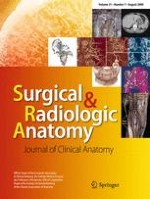01-08-2009 | Original Article
64-row MDCT review of anatomic features and variations of the normal greater omentum
Published in: Surgical and Radiologic Anatomy | Issue 7/2009
Login to get accessAbstract
Background
There are only few basic papers treating of the imaging features and anatomic variations of the normal greater omentum (GO). The goal of our study was to exploit the new major capabilities of 64-row MDCT—in terms of spatial resolution and crucial improvements in the quality of 2D and 3D reformatted images—to extensively review the in vivo anatomy, landmarks and variations of the normal GO a large cohort of patients.
Methods
The abdominal 64-row MDCT of a series of 111 patients (51 females and 60 males) were scrupulously retrospectively analysed to individually characterize the morphologic and anatomic features of the GO through multiplanar reconstructions, various methods of measure and selective volume rendering views.
Results
The GO was clearly identified, localized and characterized in all patients. The good delineation of the GO vessels, which predominantly have a vertical course, was the key of this analysis. Several individual and sex related anatomic variations were found. In females the left hemi-GO was found being statistically significantly longer than the right (P = 0.0053) but also longer than the male left hemi-GO (P < 0.0001). On the contrary, no statistically significant variation was found between the length of the left and right hemi-GO in males and between the length of the right hemi-GO in males and females. The average length of the entire GO also appeared sex-related being very statistically significantly longer in females than in males (P = 0.0002). In males the mean thickness of the GO (mtGO) was paralleling the increasing of the maximal thickness of the subcutaneous fat (mtSF). In females it remained rather independent from the increasing of the mtSF and, as a consequence, in obese and very obese females the increasing volume of the abdomen is caused preponderantly by the increasing amount of SF. In most males and females the mtGO followed the increasing of the amount of intraabdominal fat. Finally the projection of a less or more important portion of the GO into the pre-hepatic sub-phrenic space was an almost exclusive male feature found in 32% of males versus only 2% in females.
Conclusion
Abdominal 64-row MDCT is able to perfectly delineate the anatomy and landmarks of the normal GO. Our study reveals several sex related anatomical variations. Knowledge of these anatomic variations may be helpful for a better understanding and diagnosis of various pathologic processes involving the GO including vascular, inflammatory and neoplastic diseases but also for surgical therapy planning including reconstructive surgery.





